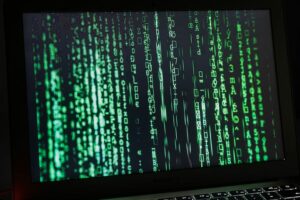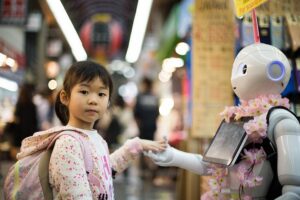



Author: Pallavi Bhagat
In its simplest form, artificial intelligence is a field that utilizes computer science and robust datasets to enable problem-solving. Over the years, artificial intelligence has gone through many cycles of hype, but even to skeptics, the release of OpenAI’s ChatGPT seems to mark a turning point. The last time generative AI loomed this large, the breakthroughs were in computer vision, but now the leap forward is in natural language processing. And it’s not just language: Generative models can also learn the grammar of software code, molecules, natural images, and various other data types. This technology’s applications are growing daily, and we’re just starting to explore the possibilities.
Are we in the Matrix?, the iconic movie, raising questions about ethical dilemmas like control of technology, blurring of reality, and simulation, like virtual reality, augmented reality, and deep fake technologies, can manipulate our perception of reality and the potential consequences of AI surpassing human intelligence?

“The Matrix” is a thought-provoking analogy to our current AI landscape.
It seeks to speculate about the power dynamics between humans and AI, the potential loss of human agency, and the existential questions that arise when technology becomes indistinguishable from reality. Considering the movie’s themes allows us to consider similar ethical issues in our AI-driven world.
Ethical dilemmas of AI development
AI being biased
AI systems deliver biased findings. Search engine technology is not neutral since it processes big data and prioritizes results with the most clicks based on user preferences and location. As a result, a search engine can become an echo chamber, perpetuating real-world prejudices and stereotypes and further entrenching them online.

A facial recognition algorithm, for example, could be trained to recognize a white person faster than a black person because this data type has been used in training more frequently. This can hurt minority groups because discrimination impedes equal opportunity and perpetuates oppression. The problem is that these biases are not intentional, and it is easier to detect them when they are all programmed into the software simultaneously.
The Intricate Dance Between AI and Job Disruption in the Workforce
According to a new World Economic Forum report, the world of work will undergo significant changes in the coming years, with nearly a quarter of jobs changing in the next five years.

Some 23% of jobs will be disrupted, WEF said in its ‘Future of Jobs’ report, with some eliminated and others created. Crucially, WEF expects 14 million fewer jobs over five years, as an estimated 83 million roles will disappear, while only 69 million will emerge.
The report’s findings are primarily based on a survey of 803 companies that employ 11.3 million workers in 45 different economies worldwide.
According to the WEF, many factors, including technological advancements such as artificial intelligence and climate change, will play a role in the disruption. Concerns about technological changes affecting jobs have grown, particularly since generative AI tools like ChatGPT have entered the mainstream. According to the study, technology is one of the leading causes of job loss.
“The largest losses are expected in administrative roles and in traditional security, factory, and commerce roles,” the report said, noting that the decline of administrative roles, in particular, will be “driven mainly by digitalization and automation.”
However, the surveyed companies do not see technological shifts as a negative overall.
“The impact of most technologies on jobs is expected to be a net positive over the next five years. Big data analytics, climate change and environmental management technologies, and encryption and cybersecurity are expected to be the biggest drivers of job growth,” the report reads.
Some sectors that could see boosted job creation linked to technology are education, agriculture, and health.
AI is described as a “key driver of potential algorithmic displacement” of roles in the report, and almost 75% of companies surveyed are expected to adopt the technology. Some 50% of the firms expect jobs to be created as a result, while 25% expect job declines.
Another challenge is the invasion of privacy; AI systems require massive amounts of (personal) data; if this data falls into the wrong hands, it can be used for nefarious intent, such as identity theft or cyberbullying.
Human-Machine Relationship:
The evolving relationship between humans and AI systems poses ethical questions. As we increasingly rely on AI for decision-making, concerns about losing human autonomy and becoming overly dependent on technology arise. Striking a balance between human judgment and AI assistance is crucial to preserve human agency and prevent undue influence.

The OECD Council Recommendation on Artificial Intelligence, adopted in May 2019, identifies the five fundamental principles for responsible stewardship of trustworthy AI that should be implemented by governments, organizations, and individuals. Today, these principles serve as a reference framework for international standards and national legislation on AI.
In addition to international and regional efforts on AI governance include UNESCO’s Recommendation on the Ethics of AI, the Council of Europe’s proposal for an artificial intelligence legal framework based on the Council’s standards on human rights, democracy, and the rule of law, and a series of documents that define the EU’s approach to AI. The European Union’s “Artificial Intelligence Act,” for example, proposes a legal framework for reliable AI.
At the national level, governments have developed AI strategies, which, among other things, outline approaches for trusted and safe AI.
From the private sector perspective, several businesses, including Google and Microsoft, have developed governance tools and principles for responsibly building AI systems that outline practical approaches to ensure that the unintended consequences of the technology are avoided.
Ethical issues arise in the context of autonomous AI systems such as self-driving cars and self-driving weapons. The issues of responsibility, liability, and accountability in the event of accidents or harm caused by autonomous systems are complex, and they necessitate careful legal and ethical frameworks to ensure that the benefits of these technologies are realized without jeopardizing human safety and well-being.
Furthermore, broader societal and philosophical questions surround AI, such as the potential for AI to replicate human intelligence and emotions and the ethical implications of creating AI systems that may have moral agency or consciousness. These questions raise profound ethical quandaries that question our understanding of humanity and require careful reflection and debate.
If AI continues to improve, it will raise moral issues that we must consider and act upon. It’s crucial to confront ethical challenges such as the impact on jobs, fairness and responsibility in AI algorithms, safeguarding confidential data, operating autonomous AI systems effectively, and resolving questions related to society and philosophy. These ethical problems must be handled responsibly to ensure AI’s advancement and safe use to serve mankind’s greater good. Collaboration is critical for creating ethical frameworks, policies, and regulations that govern the development and use of AI in a manner that preserves human values, safeguards human rights, and guarantees a fair and inclusive future for all parties involved. This requires a joint effort between individuals, organizations, and governments.





